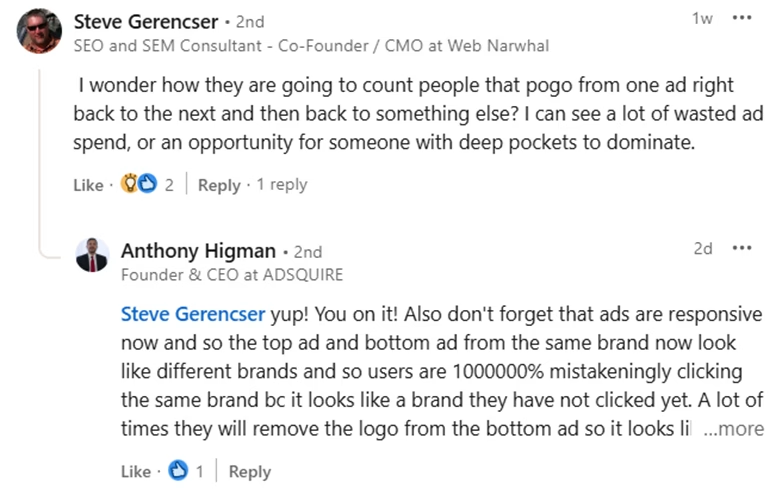It wouldn’t be fair for one single brand to take up all the ad space real estate. That’s one reason Google Ads has the unfair advantage policy in place. It limits the same account from having multiple ads rank in any given auction, and it’s certainly not going anywhere anytime soon.
However, with Google evolving its ad auction approach and individual ad placements having their own separate auctions, the unfair advantage policy is getting a mini facelift. On April 14, 2025, Google will enact a slight change to this policy that, for the first time ever, will allow the same brand to rank in multiple ad locations on the same page.
This is a pretty big change. Let’s take a closer look at the potential repercussions of this update.
Contents
What’s changing
In April 2025, Google updated its unfair advantage policy so that the limit for the same account showing multiple ads only applies per single ad location—rather than across all locations as the policy previously stated. So, you can have multiple ads for the same business, app, or site in different locations on the same search results page.
Recently, Google had been testing multiple ads from the same brand on the page to provide more opportunities for visibility and clicks for top advertisers. This is just the latest change in a series of other experiments Google has been running in the past year or so, like blending ads with organic results and redefining top ad placements. Between AI Overviews and more, there’s no doubt the standard search results are changing, so with this update, there are more potential placements your business can show.
Here is the full announcement from Google:
“On April 14, 2025, Google will update its Unfair advantage policy to clarify that our prohibition on showing more than one ad at a time for your business, app, or site applies only to a single ad location. Specifically, the Unfair advantage policy will be updated to read:
The following is not allowed:
Using the Google Network to gain an unfair traffic advantage over other participants in the auction
Examples (non-exhaustive): Affiliates that advertise on Google Ads against the applicable affiliate program rules; trying to show more than one ad for your business, app, or site in a single ad location.”
You can already start to see this update in action. In the example below, there are ads for JustAnswer in the top ad spot and then again further down the page.


❓Is your Google Ads account ready to take on the latest platform updates? Find out with our Free Google Ads Grader!
What this means for advertisers
If you’re wondering what this all means for your business’s Google Ads account, here are the top things you need to know (so far).
Ad competition and costs could be majorly impacted
Since this is the first time ever that the unfair advantage policy has been adjusted to permit double serving, there’s no doubt that this update could have a major impact on Google Ads competition and costs (which, as we recently covered, have been increasing steadily).
“I see this change as a big deal, especially for smaller advertisers,” said Cliff Sizemore, Senior Growth Marketing Manager at LocaliQ.
“This update gives even more reason to diversify your placements as a small business advertiser. Eventually, if it drives up costs too high, I can see some of the smaller advertisers shifting their paid search strategies entirely,” said Cliff.
For example, aligning with the updated unfair advantage policy might mean rethinking your campaign budgets.
“Medium-budget advertisers theoretically could allocate more resources toward dominating search results for a particular service line (e.g., siding repair),” said Guy Philosoph, Head of Product Management for LocaliQ’s Lead Generation Paid Media Products.
So, with more opportunities for the same brands to show on the page, advertisers with smaller budgets may need to reallocate funds across campaigns (or reprioritize campaigns entirely) to maximize their bids and maintain their Ad Rank.
Long story short, small businesses are most likely going to be feeling the downsides of this update the most. For instance, Chris Chambers, Head of Paid Search at Understory, commented the following on LinkedIn:
“It seems like now the advertisers with the most to spend in each niche will get even more real estate and be able to show twice, potentially cutting out smaller competitors completely from the first page.”

⚡ Learn how to improve your Quality Score and save big in Google Ads here!
Advertisers may have trouble measuring results
While, initially, it’s safe to assume that the updated unfair advantage policy could make the ad auction more volatile, this change is still fresh. So far, the overall sentiment from the PPC community is that more time is needed before solid predictions can be made regarding the impact the updated unfair advantage policy will have. On top of that, it’s going to be difficult to fully track the impact of this update, and advertisers may have trouble measuring results.
Navah Hopkins, Brand Evangelist at Optmyzer, writes on LinkedIn:
“Google is officially making it fair game to have more than one spot on the SERP… I want to see how performance actually shakes out in Q2.”

Some of the comments in reply to her post, however, still raise concerns about increased impressions and clicks to the same business, equating to wasted spending. There’s also a lack of clarity around how multiple impressions and clicks to the same brand will be accurately measured.
For example, Steve Gerencser, Co-founder and CMO at Web Narwhal, commented:
“How are they going to count people that pogo from one ad right back to the next and then back to something else? I can see a lot of wasted ad spend or an opportunity for someone with deep pockets to dominate.”

Chris shared concerns about reporting in his comment:
“This is going to be wild from a metric reporting standpoint since it seems like right now it counts as two impressions and affects your impression share and position in auction insights.”
So, while there’s a lot of speculation around how this change could have a negative impact on the digital ad space, data to prove this update’s implications remains to be collected.
Agencies may have more competition directly from the big players
This change could also pose issues for digital marketing agencies trying to rank for Google Ads-related content or platform-specific content. “This will bring difficulties for digital marketing agencies, too. It means Google can also rank themselves multiple times,” said Cliff.
For instance, keywords relating to digital marketing strategies and solutions that include a platform name, like “Facebook Ads,” are already extremely competitive both from the paid and organic perspectives. Now, the platforms themselves could make this even worse by showing multiple times throughout the SERP thanks to their mega budgets—pushing ads from marketing agencies down even further.

Facebook Ads dominates the SERP for this brand-related search.
Tips to maintain your Ad Rank across ad locations
If you’re concerned your competitors’ ads may start to show more than yours throughout the SERP, here’s our advice.
Don’t make any major changes…yet
The Google Ads unfair advantage policy goes into effect on April 14, 2025. Regardless of whether your business sees a positive or negative change in performance (or any change at all) because of this update, it would take a few months’ worth of data before you’d know for sure.
Sometimes, the hardest part of PPC is patience. While it can be tempting to start restructuring your campaigns now, you’ll want to avoid any major budget or account changes while this update takes effect over the next few months. That way, you’ll be able to make the most informed, data-backed decisions when it comes time to reoptimize.
For now, use reports like Auction Insights within Google Ads to keep a close eye on your rank in the ad auction.

Rethink your keyword and budget strategies
As this update evolves, be sure to use industry benchmarks, as well as your own key PPC metrics, to see if your account’s costs sway. From there, campaign components like your budgets and keyword lists will have the biggest connection to maintaining your Ad Rank at a low cost.
“Advertisers with lower budgets may see a rise in competition for traditionally less competitive keywords. If impacted, these low-budget advertisers would need to be more strategic about keyword research and budgeting than ever before, targeting search queries that balance high search volume with low competition,” said Guy.
Guy added as a note for our clients: “LocaliQ will begin actively monitoring performance on April 14 to assess potential impacts on our clients’ campaigns and will take proactive measures based on the insights we gather.”

As competition increases due to the unfair advantage policy update, our Google Ads Benchmarks Report can help you see how your cost per click is pacing against your industry’s average.
💡 Refine your keyword lists and only bid on low-competition, high-value terms using our Free Keyword Tool!
Be open to new placements and supplemental channels
If you find yourself gravitating toward other channels to supplement your Google Ads, you’re on the right track. As Cliff mentioned above, many small business advertisers may have to be agile with their paid search strategies in light of this change. That might mean diversifying your Google Ads placements and campaign types to increase your chances of showing more than once on a page.
Plus, almost half of the small businesses surveyed in the latest Small Business Marketing Trends Report from LocaliQ reported using search advertising in tandem with other marketing channels. This can help you build an effective, always-on approach to marketing and advertising that allows you to fill performance gaps between platforms during times of unrest.

Stay ahead of Google changes this year
We’re still early in the year, and with Google Marketing Live on the horizon in May, this major platform change is just one of potentially many that might come our way in 2025.
Stay up to date on industry trends, your campaign performance, and the latest platform changes to be ahead of the game. Plus, our solutions can help you navigate platform updates and maximize campaign performance to maintain a competitive edge no matter what.







